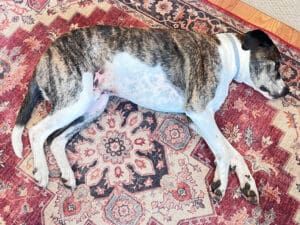
There is no sound in the world that can wake up a dog owner faster than the “Ulp, ulp, ulp” sound of a dog who is about to vomit. But is there any sound that’s more annoying, and then concerning, than “Lick, lick, lick, lick?”
It’s spring-time allergy season around here, and if that licking sound wasn’t already tipping me off, my own incredibly itchy eyes would fully inform me of that fact. Where I live, close to the upper right edge of California’s 450-mile-long Central Valley, we’ve had abundant rainfall for the second year in a row and the drought-stricken trees are celebrating with the most bounteous pollen dusting I’ve ever seen. Everything outdoors is covered with yellow powder – and of course, our dogs can’t so much as step outside without getting that pollen all over their feet.
At 2 years old, Boone so far seems impervious, which is awesome. But, about three years ago, poor 8-year-old Woody started suffering in the spring. He’s never scratched or licked himself so much that he’s gotten a hot spot, but that’s only because I work hard to keep him comfortable. He focuses all of his attention to his bare tummy and inner thighs, which become pink and irritated from all of that licking, but, at least so far, he has not developed a secondary bacterial infection.
In an attempt to reduce his exposure to all of that pollen, I have been trying to keep Woody indoors, and trying to rinse and dry his feet and wipe his coat with a towel every time he comes back indoors after being outside. I say “try,” because with two other humans in the house (my husband and our 11-year-old grandson), neither of whom are all that attentive to Woody’s allergy symptoms, he keeps getting let outdoors when I’m otherwise occupied. Woody wants to be outside, he keeps asking them to let him outside. The weather has been so warm and delicious lately, all he wants to do is lie in the sun on the warm deck or roll around on the lawn . . . the pollen-covered deck and lawn. Argh!
A few years ago, I became a convert to the benefits of Apoquel and Cytopoint, which are relatively new medications for dogs with severe allergies. For the past three years, I’ve made an appointment with our veterinarian to get Woody a prescription for Apoquel when the “lick, lick, lick” sound signaled the start of his allergy season. But this year, I’ve also made a call to get an appointment to discuss getting him an injection of Cytopoint, after seeing what it did for my sister’s little white terrier-mix Daisy.
Like Woody, Daisy suffers from spring-time allergies, but she also suffers in the fall, when the rain starts and fungal spores start to bloom. Because I am the designated veterinary driver in my family, last fall, when her itching became overwhelming, I brought her to a vet who recommended Cytopoint over Apoquel as a symptom reliever. Apoquel has a dampening effect on the immune system, which calms the hypersensitivity to pollen, but this can also cause any tumors the dog might have to grow unchecked by the immune system. We don’t know that Daisy (who is at least 12 years old) has any tumors, but it was her vet’s opinion that many older dogs do, and why mess around with that when Cytopoint, which doesn’t have this potential side effect, works just as well or better? She gave Daisy an injection of Cytopoint, and it worked like a miracle drug; she stopped licking and scratching herself within hours. Daisy didn’t scratch or lick herself for months – until recently, in fact, when my sister took her in for another injection.
When someone is allergic to something, the best course of action is to prevent their exposure to it – and that’s where I am coming from with trying to keep Woody indoors while the trees are dumping so much pollen, and wiping him down and hosing his feet before he comes inside from his required trips outdoors. But the pollen is everywhere; it cannot be completely evaded in our rural home. So some symptom control is both reasonable and appreciated.


